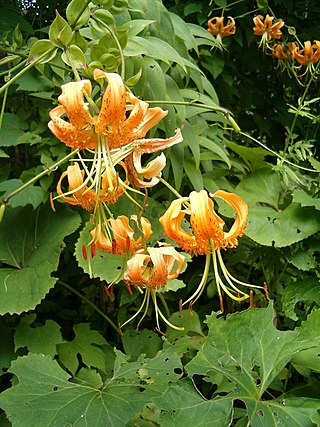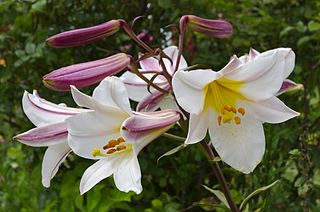
Lilium is a genus of herbaceous flowering plants growing from bulbs, all with large and often prominent flowers. Lilies are a group of flowering plants which are important in culture and literature in much of the world. Most species are native to the Northern Hemisphere and their range is temperate climates and extends into the subtropics. Many other plants have "lily" in their common names, but do not belong to the same genus and are therefore not true lilies. True lilies are known to be highly toxic to cats.

Lilium martagon, the martagon lily or Turk's cap lily, is a Eurasian species of lily. It has a widespread native region extending from Portugal east through Europe and Asia as far east as Mongolia.

Lilium henryi, sometimes called tiger lily or Henry's lily, is a native lily of the mountains of central China. The flowers are orange, spotted black, and unscented. The petals are recurving, and eventually resemble those of the more widespread Turk's-cap lily.

Lilium speciosum is an East Asian species of plants in the lily family. It is native to southern Japan and southern China, where it can be found at elevations of 600–900 metres (2,000–3,000 ft). It is sometimes called the Japanese lily though there are other species with this common name.

Cardiocrinum is a genus of bulbous plants of the lily family first described in 1846. They are native to the Himalaya, China, the Russian Far East, and Japan. The bulbs are usually formed at the soil surface. The preferred habitat is woodland. The plants tend to be monocarpic, dying after flowering.

Lilium regale, called the regal lily, royal lily, king's lily,or, in New Zealand, the Christmas lily, is a species of flowering plant in the lily family Liliaceae, with trumpet-shaped flowers. It is native to the western part of Sichuan Province in southwestern China, and cultivated elsewhere as an ornamental. It was introduced to England in 1903 by Ernest Henry Wilson.

Lilium columbianum is a lily native to western North America. It is also known as the Columbia lily, Columbia tiger lily, or simply tiger lily.

Lilium washingtonianum is a North American plant species in the lily family. It is also known as the Washington lily,Shasta lily, or Mt. Hood lily. It is named after Martha Washington and not the state of Washington; in fact, as the northern range of the plant is near Mount Hood in Oregon, it does not naturally occur in the state of Washington.

Lilium nepalense, the lily of Nepal, is an Asian plant species in the lily family. It is native to the Himalayas and nearby regions: northern Thailand, northern Myanmar, Assam, Bhutan, Sikkim, Nepal, Uttarakhand, Tibet, and Yunnan. It can be found growing on wet forest borders at 1,200 to 3,000 m.

Lilium maculatum is a plant in the lily family native to Japan.

Lilium cernuum is a species of lily native to Korea, the Primorye region of Russia, and northeastern China.

Lilium pensylvanicum is an Asian plant species of the family Liliaceae. Sometimes called the Siberian lily, it is native to a cold climate and needs frost in the winter. It is found in the wild form in Siberia, the Russian Far East, Mongolia, northeast China, Korea and Hokkaidō.

Lilium tsingtauense, also known as twilight lily, is an East Asian species of plants in the lily family. It is native to Korea and eastern China.

Lilium grayi is a perennial plant that is endemic to the eastern US states of North Carolina, Virginia, and Tennessee, growing in moist, acid soil in the Appalachian Mountains on higher elevation meadows, bogs, and seeps. The plant was introduced to Royal Botanic Gardens, Kew in 1890 and was featured in the Kew Bulletin in 1892.

Lilium hansonii, known as Hanson's lily and Japanese turk's-cap lily, is an East Asian species of plants in the lily family. It is native to Korea, Japan, and to Jilin Province in northeastern China, as well as being widely cultivated as an ornamental.

Lilium fargesii is a Chinese species of plants in the lily family native to Hubei, Shaanxi, Sichuan and Yunnan provinces of China.

Lilium distichum is an Asian species herbaceous plant of the lily family which is native to northeastern China, Korea, and eastern Russia.

Lilium concolor is a species of flowering plant in the lily family which occurs naturally in China, Japan, Korea and Russia. Its relationship with other species is not clear, although it has some similarities to Lilium pumilum.

Lilium formosanum, also known as the Formosa lily or Taiwanese lily, is a plant species in the lily family, endemic to Taiwan. It is closely related to the Easter lily found in the Ryukyu Islands of Japan, eastern and northern Taiwan. Both species are cultivated for their showy, trumpet-shaped flowers. Lilium formosanum has become naturalized in scattered locations in Africa, Australia, and the Americas.

Lilium brownii var. viridulum is a variety of Lilium brownii native to China.
























